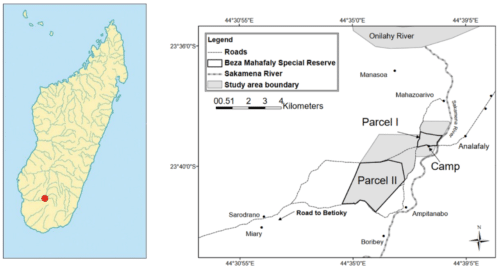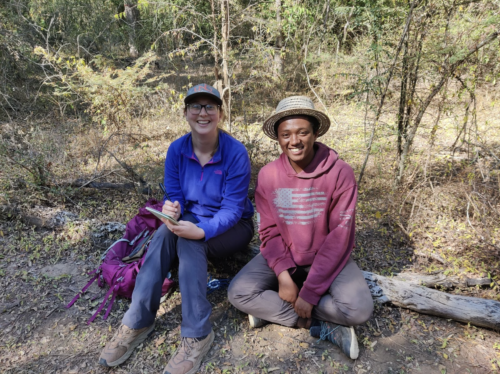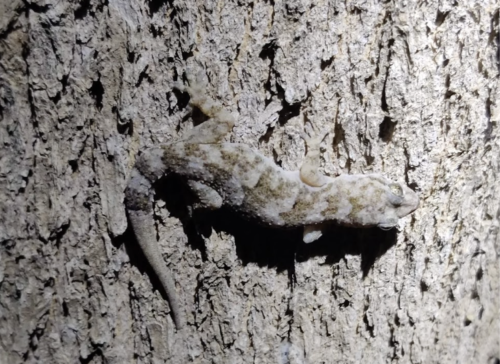Beza Mahafaly Special Reserve was originally established as a reserve in 1977 and has been recognized as a protected area since 1986. Beza Mahafaly has attracted many researchers over the last four decades, including renowned primatologist Alison Richard who led a 40-year demographic study on Verreaux’s sifaka here.
I was first introduced to Beza Mahafaly by my graduate advisor, Anne Axel, in the summer of 2019. My quick visit gave me a taste of Beza and I knew that I wanted to return. I instantly fell in love with Beza for the simplicity, the quiet, the lovely people, and the awe-inspiring wildlife. It’s a peaceful haven where you can unplug and tune into the beauty of the forests. I love how safe and at home I feel at Beza.
Beza Mahafaly truly is a nature lover’s paradise.
Located in southwestern Madagascar, Beza Mahafaly Special Reserve boasts a unique landscape of gallery, spiny and dry deciduous forests. I enjoyed being able to explore Parcel 1 by myself and go for runs along the tourist circuit. While I wouldn’t normally recommend venturing into Madagascar’s forests solo, Parcel 1 is small, extremely well marked, and directly adjacent to camp.

Wildlife in Beza
In addition to 6 species of lemur and many bird species, other wildlife that can be found around Beza include the infamous Madagascar forest cat, scorpions, chameleons, hissing cockroaches, and many other fascinating creatures.
Lemurs
Lemurs that can be found at Beza include:
- Ring-tailed lemur (Lemur catta)
- Verreaux’s sifaka (Propithecus verreauxi)
- Fat tailed dwarf lemur (Cheirogaleus medius)
- Petter’s sportive lemur (Lepilemur petteri)
- Gray-brown mouse lemur (Microcebus griseorufus)
- Gray mouse lemur (Microcebus murinus).

Birds
Beza also hosts many diverse species of birds, including:
- Several species of Coua
- Several species of Vanga
- Madagascar Hoopoe (Upupa marginata)
- Madagascar Magpie-Robin (Copsychus albospecularis)
- Malagasy paradise-Flycatcher (Terpsiphone mutata)
- Crested Drongo (Dicrurus forficatus)
You can also spot various birds of prey, and many more bird species!
Botanical Garden
There is also incredible plant diversity at Beza, including Octopus trees (Didierea madagascariensis) in the open spiny forests and Tamarind trees (Tamarindus indica) in the dense gallery forests adjacent to the Sakamena river. A botanical garden located in camp will help familiarize you with the native species.
Nearby Places to Visit
Milomboka Community Forest
This forest is about an hour and a half drive north of Beza Mahafaly. It is protected by the community. Visiting can be arranged by the site manager at Beza. Keep in mind you will need to pay for a guide from Beza to accompany you as well as a guide from Milomboka. Before entering the forest, there will be a gathering with the community members who protect the forest.
The Milomboka Community Forest is much wetter than the Beza forests due to its proximity to the Onilahy River and has a very different feel to it! The wildlife are different here too. While no fossa have been detected in Beza, we captured fossa on camera traps in the Milomboka forest.
Read a preliminary survey of native and invasive carnivores in the Milomboka Community Forest.
Razoara
Razoara is walking distance from camp and takes about an hour and a half to reach. Again, visiting can be arranged by the site manager at Beza. From the village, you cross through forest before reaching a wide, expansive canyon filled with streams and small caves. I highly recommend visiting here if you’d like to see fruit bats (Pteropus rufus)!
A Typical Day at the Beza Mahafaly Special Reserve
Here’s what a typical day at Beza could look like:
Commune Over Meals

The breakfast bell rings around 7 AM. The cook will have prepared what you gave them the night before. Yes, this can include coffee! We typically had vary sosoa (a wet rice porridge) with greens and sometimes eggs. Always provide more food than you think you need as guides will often join for breakfast. Also bring plenty of sugar with you to camp, the Malagasy LOVE sugar in their coffee. Leftovers will always be appreciated by the cooking team!
Spend Your Day in the Forest or Relaxing in Your Hammock
As a researcher, I would typically head into the field after breakfast. However, as a tourist you get to decide! You can plan to explore Parcel 1 with a guide or coordinate with your driver to visit Parcel 2 of the reserve.
Before heading into the field, you will give the cook what you would like for lunch and let them know around what time you’ll be back for lunch. Your guide may stay with you for lunch, especially if you plan to head back into the forest afterwards. After lunch, you’ll give the cook what you plan to have for dinner. If you’ve had enough exploring for the day, you could choose to read a book in your hammock or take a nap, hang out with the people at camp, or just find a spot nearby to sit and watch for lemurs!
I often enjoyed spending afternoons with my field assistants and the children who lived in and around camp. Photos: Brynn Harshbarger.
The dinner bell typically rings around 7 or 8 in the evening. There were several nights we gave the cook peanuts to roast for us as an appetizer and occasionally treated ourselves to THB (Malagasy beer). If you do bring alcohol with you, make sure to bring enough to share. I always looked forward to dinner time where I could unwind with friends and enjoy good food. After dinner, you’ll give the cook what you’d like for breakfast the next morning.
Go for Evening Walks and Gaze at the Stars
There were plenty of nights where I’d crash in my tent with a book after dinner, but other nights we’d walk the road outside of camp looking for mouse and dwarf lemurs.
The nocturnal lemurs at Beza are just as fun to watch as the diurnal (daytime) ones; we almost always saw mouse lemurs in the evenings! The stars at night are also stunning; I enjoyed star-gazing from my hammock before turning in for the night.
Conducting Lemur Research in Beza Mahafaly
In the summer of 2023, I spent a couple months at Beza Mahafaly studying seed dispersal by ring-tailed lemurs. I was interested in the role ring-tailed lemurs play in dispersing seeds throughout the forest. Specifically, I wanted to understand the spatial distribution pattern of seeds dispersed by ring-tailed lemurs and how effective they were as dispersers. I focused on dispersal of seeds from Tamarind trees (Tamarindus indica), which are prevalent throughout the reserve.
The lemurs are well habituated and easy to follow. However, unlike the sifaka at the reserve the ring-tailed lemurs do not have collars and observation of a single individual is difficult! Luckily, the guides are well-skilled at identifying subtle differences between individuals and keeping track of movement.

Visiting Beza Mahafaly Special Reserve
Beza Mahafaly is not a popular tourist destination largely due to its remote location. It’s worth the trek if you are able to spend at least a few nights in camp.
Getting There

Some visitors opt to drive to Beza from Antananarivo (Tana) while others fly to the closest airport located in Toliara.
From Tana
The trip from Tana could be completed in about 3 days, or longer if you’d like to visit other destinations along the route. Travelling south from Tana to Beza along RN7, you pass by Ranomafana National Park and Isalo National Park (both very popular tourist destinations!). Ranohira (the village adjacent to Isalo NP) has decent hotels and is a good last stop option before the final trek to Beza. The stretch from Ranohira to Beza is around 8 hours.
After arriving in Andranovory, you will turn off the main road (RN7) and onto RN10. The drive from Andranovory to Beza takes around 6 hours and is along a bumpy dirt road. This stretch of road makes me think of the African savanna; it’s a beautiful yet nauseating ride. Pack some dramamine! Betioky is the last town you’ll encounter before turning east towards camp. You may decide to stop here to pick up a few last minute grocery items at the market before making the final 1-2 hour drive to camp.
From Toliara
If driving from Toliara, the trip takes around 8 hours and is mostly on dirt roads. Again, pack some dramamine!
Infrastructure for Tourism and Research
The infrastructure at Beza consists of a small museum where visitors can learn about the Mahafaly people (the local ethnic group), a large central pavilion, a small house with a couple rooms for staff and a dining area, an outdoor kitchen with an wood-burning fire where meals are cooked, several raised tent sites, pit toilets, shower stalls where you can take bucket showers or bring your own solar shower, water containers, and a well.
The staff do an excellent job keeping the bathrooms cleaned, the water containers filled, and the grounds overall in great shape!
Supplies to Bring to Camp
Visitors need to pack in all of their own supplies. Things to bring include:
- Water filter
- Solar shower (if you prefer warmer showers)
- Camping equipment (tent, pad, sleeping bag, hammock, camp chair, head lamp, lantern)
- Toiletries (including toilet paper)
- First aid supplies
- Food
- Food storage (tent or sealed storage container to keep out the wildlife!)
- Laundry: If you need to do laundry while at camp, you can bring your own supplies or pay the cleaning staff a small fee to wash clothes for you.
Fees and Contacts for Visiting as a Tourist or Researcher
If you are interested in visiting Beza, contact the site manager Tojosoa Tamby Razanakolona. He can put you in touch with the representative at Madagascar National Parks.
- WhatsApp: +261 34 91 664 09
- Email: tojo.perso@gmail.com
Tourist Fees
As of March 2025
- Nightly camping fee: 10,000 Ariary per person (approximately $2 USD)
- Park entrance fees: Adult: 45,000 Ariary (approximately $10 USD); Youth: 25,000 (approximately $6 USD)
- Guide fee: 50,000 Ariary (approximately $10 USD)
- Daily cook fee: Groups of up to 5 people: 5,000 Ariary (approximately $1 USD); Groups of 6–7 people: 7,000 Ariary (approximately $2 USD); Groups of 8–10 people: 10,000 Ariary (approximately $2 USD)
Research Permits
I worked with MICET to obtain my research permit and all required paperwork. Find the most updated information available on MICET services and fees; the email contact is micet@moov.mg.
You may also contact me personally at bmharshbarger [at] gmail.com for details on how to prepare for research at Beza.
For up close observation of ring-tailed lemurs or Verreaux’s sifaka, Beza Mahafaly is an incredible place to work. If you are a researcher interested in working at Beza, know that you will be well supported by the monitoring team!
About the Author
Brynn Harshbarger has volunteered and done research in Madagascar since 2018. She is dedicated to doing what she can to increase awareness of Madagascar’s incredible biodiversity! Her career path has led her to conduct research on lemur movement and seed dispersal, teach youth on animal behavior and conservation as a zoo education director, and currently to serve as a project coordinator for a non-profit at the University of Pittsburgh.




